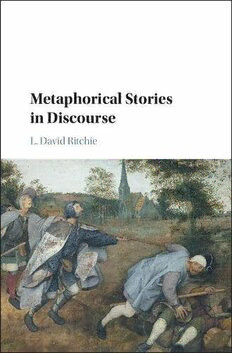
Metaphorical Stories in Discourse PDF
Preview Metaphorical Stories in Discourse
Metaphorical Stories in Discourse When Hillary Clinton conceded in 2008 that she did not quite “shatter the glassceiling,”andwhenRickPerryin2012calledMittRomneya“vulture capitalist,”theyusedabbreviatedmetaphoricalstories,inwhichstoriesabout one topic are presented as stories about something entirely different. This bookexaminesawiderangeofmetaphoricalstories,beginningwithliterary genressuchasallegoriesandfablesandthenfocusingonmetaphoricalstories in ordinary conversations, political speeches, editorial cartoons, and other communication.Sometimesmetaphoricalstoriesaredevelopedinrichdetail; inotherexamples,like“vulturecapitalist,”theymaymerelybereferencedor implied. This book argues that close attention to metaphorical stories and story metaphors enriches our understanding and is essential to any theory of communication. The book introduces a theoretical structure, which is developedintoatheoryofmetaphoricalstories,andthenillustratesthetheory byapplyingittoactualdiscourse. l.davidritchie isProfessorofCommunicationatPortlandStateUniver- sity, where he has taught since 1990. He is the author of three books, includingMetaphor(CambridgeUniversityPress,2014). Metaphorical Stories in Discourse L. David Ritchie PortlandStateUniversity UniversityPrintingHouse,CambridgeCB28BS,UnitedKingdom CambridgeUniversityPressispartoftheUniversityofCambridge. ItfurtherstheUniversity’smissionbydisseminatingknowledgeinthepursuitof education,learning,andresearchatthehighestinternationallevelsofexcellence. www.cambridge.org Informationonthistitle:www.cambridge.org/9781107168305 DOI:10.1017/9781316717172 ©L.DavidRitchie2017 Thispublicationisincopyright.Subjecttostatutoryexception andtotheprovisionsofrelevantcollectivelicensingagreements, noreproductionofanypartmaytakeplacewithoutthewritten permissionofCambridgeUniversityPress. Firstpublished2017 PrintedinTheUnitedKingdombyClaysLtd. AcataloguerecordforthispublicationisavailablefromtheBritishLibrary. LibraryofCongressCataloging-in-PublicationData Names:Ritchie,L.Davidauthor. Title:MetaphoricalStoriesinDiscourse/L.DavidRitchie,PortlandStateUniversity. Description:Cambridge:CambridgeUniversityPress,2017.|Includesbibliographical referencesandindex. Identifiers:LCCN2017011386|ISBN9781107168305(hardback:alk.paper) Subjects:LCSH:Metaphor.|Narration(Rhetoric) Classification:LCCP301.5.M48R577782017|DDC808/.03–dc23 LCrecordavailableathttps://lccn.loc.gov/2017011386 ISBN978-1-107-16830-5Hardback CambridgeUniversityPresshasnoresponsibilityforthepersistenceoraccuracy ofURLsforexternalorthird-partyinternetwebsitesreferredtointhispublication anddoesnotguaranteethatanycontentonsuchwebsitesis,orwillremain, accurateorappropriate. Contents Preface pagevii 1 “Shattering theGlassCeiling”:AMetaphor Becomes a Metaphorical Story 1 2 Storiesand Narratives 20 3 Languageand Metaphor 47 4 Allegory 79 5 Parables andFables 105 6 Metaphorical Stories 120 7 Story Metaphors and Aphorisms 133 8 Story-Metaphors inJournalism and Public Affairs 150 9 Barack Obama Talks about Race 170 10 Metaphorical Stories about Climate Change 188 11 Metaphorical Stories inVisual Communication 215 12 Metaphorical Stories and Their Place in Discourse 234 Notes 254 References 256 Index 267 v Preface The cover image, from a 16th-century painting by Pieter Bruegel the Elder titled“TheBlindLeadingtheBlind,”depictsalineofblindmenconnectedby their staffs or by a hand on the shoulder of the man in front. All are in poses suggesting forward motion. The title phrase is a familiar aphorism, often used as a metaphorical description of a situation in which a person who is giving advice knows no more than those who are receiving the advice, or in which a leader of a group is no better informed than any other member of thegroup.“Blind”implies“unabletosee.”“Tosee”ismoregenerallyusedas a metaphor for “to know,” and “leading” is generally used as a metaphor for both“governing”and“advising,”soasusedinthisaphorism,“blind”implies something like “the ignorant giving advice to the ignorant.” to see is to knowisanexampleofwhatisoftencalledaconceptualmetaphor,inwhicha generalclassofabstractideas(knowingorunderstanding)isunderstood andexperiencedintermsofobjectsoractivitiesinthehere-and-nowphysical world (eyesight). The aphorism “blind leading the blind” expresses this common conceptual metaphor in a blend with another common conceptual metaphor, life is a journey and with the irony implied by describing a seeminglycontradictoryidea(howcanablindpersonleadanyoneelse?How canapersonwhohasnoknowledgeofatopicprovideadvicetoanyoneelse?) The painting itself is an example of a particular kind of visual metaphor, inasmuch as it illustrates a common metaphorical aphorism (the title of the painting). The topic of the aphorism is not included in this image; it is left to theviewerto apply the metaphor. Thepaintingdoesnotstopatdepictingthemetaphoricalsituation,arowof blind men following other blind men. It also illustrates a metaphorical story: Theblindmanatthefrontoftheprocessionhasfallen,apparentlybecausehe stumbled on a rock shown in the path next to him. The man behind is stumbling,offbalance,andevidentlyabouttofalloverthefallenman,leading totheexpectationthatthefourmenfollowingthesecondwillalsostumbleand fall.Thestory:Agroupofblindmenisledbyanotherblindmanwhocannot seewhereheisgoingandconsequentlystumblesoveranobstacleinthepath, as aresultof which all of themen will end upfalling. vii viii Preface Understanding this painting involves some mental activities that are likely tobetotallyautomatic;atypicalviewerisunlikelytobeawareofthematall. The underlying conceptual metaphor must become activated – or rather, the aspects of the conceptual metaphor that are relevant to the painting must be partially activated and connected with the images. The title of the painting helps by cuing the familiar aphorism. The title may also cue one or more situations in which the viewer has read or heard this aphorism in connection withaparticulartopic;ifso,thosesituationsarealsolikelytoberecalled,and connected with thepainting. Ifirstbecameinterestedinmetaphoricalstorieswhen,aspartofaworkshop onmetaphoranalysisorganizedbyLynneCameronattheUniversityofLeeds, Iparticipatedinaline-by-lineanalysisofaspeechbyTonyBlair,thenBritish primeministerandleaderoftheLabourParty.Inthisspeech,Blairdeveloped astoryaboutamaritaldisputethatinvolvesthewifethrowingdishes(“crock- ery”), a commonplace in TV situation comedies and newspaper comic strips, asametaphor for his owndisputewith adiscontentedsegmentoftheLabour Party.AsIstudiedthatspeech,Ialsonoticedanumberofphrasesthatimplied metaphoricalstoriesbutdidnotspellthemout(e.g.theConservativePartyas aburglar,tryingtoentergovernment“throughthebackdoor”).AsIanalyzed other texts, including several conversations about relations between police and community, I encountered other metaphorical stories and other short phrasesthatalludetoorimplymetaphoricalstories.Some,likeBlair’s“throw- ing crockery” story, drew on popular culture. Others drew on or developed conceptual metaphors inquite originaland creative ways. Theseearlyexperiencesledtothisbook,andmanyoftheexamplesusedin this book are drawn from those early studies. Initially I attended primarily to casual, nonliterary metaphorical stories; only as I began to prepare this book did I broaden the scope to include the literary genres such as allegories and parablesthathavebeenthefocusofmostpreviousresearchonthistopic.Even then, I have retained a primary focus on metaphorical stories that are related or alluded to in “ordinary” (nonliterary) discourse. I quickly discovered that political discourse, including news coverage and editorial cartoons as well as ordinary conversations about political topics, is a rich source of entertaining andoftenwittymetaphoricalstories.Asaconsequence,manyoftheexamples inthisbookaredrawnfrompoliticaldiscourse including speeches,editorials, and editorial cartoons. Aninevitableconsequenceofdrawingexamplesfromcontemporaryhistory is that the context of the examples continually changes as history continues to move and develop. As the context of a metaphorical story changes, the understanding of it must also change – and the context of political discourse canchangequiterapidly.Oneexampleofthisinteractionbetweenhistoryand language /languageanalysisappears in Chapter 1, much ofwhichisdevoted
